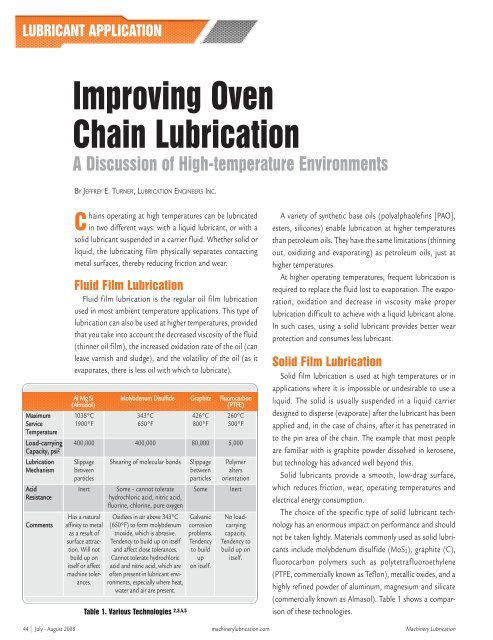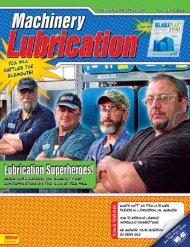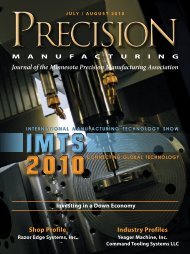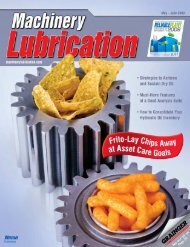Machinery Lubrication July August 2008
Machinery Lubrication July August 2008
Machinery Lubrication July August 2008
You also want an ePaper? Increase the reach of your titles
YUMPU automatically turns print PDFs into web optimized ePapers that Google loves.
LUBRICANT APPLICATION<br />
Improving Oven<br />
Chain <strong>Lubrication</strong><br />
A Discussion of High-temperature Environments<br />
BY JEFFREY E. TURNER, LUBRICATION ENGINEERS INC.<br />
Maximum<br />
Service<br />
Temperature<br />
Chains operating at high temperatures can be lubricated<br />
in two different ways: with a liquid lubricant, or with a<br />
solid lubricant suspended in a carrier fluid. Whether solid or<br />
liquid, the lubricating film physically separates contacting<br />
metal surfaces, thereby reducing friction and wear.<br />
Fluid Film <strong>Lubrication</strong><br />
Fluid film lubrication is the regular oil film lubrication<br />
used in most ambient temperature applications. This type of<br />
lubrication can also be used at higher temperatures, provided<br />
that you take into account the decreased viscosity of the fluid<br />
(thinner oil film), the increased oxidation rate of the oil (can<br />
leave varnish and sludge), and the volatility of the oil (as it<br />
evaporates, there is less oil with which to lubricate).<br />
Al Mg Si Molybdenum Disulfide Graphite Fluorocarbon<br />
(Almasol)<br />
(PTFE)<br />
1038°C<br />
1900°F<br />
343°C<br />
650°F<br />
426°C<br />
800°F<br />
260°C<br />
500°F<br />
Load-carrying 400,000 400,000 80,000 5,000<br />
Capacity, psi 2<br />
<strong>Lubrication</strong><br />
Mechanism<br />
Acid<br />
Resistance<br />
Comments<br />
Slippage<br />
between<br />
particles<br />
Inert<br />
Has a natural<br />
affinity to metal<br />
as a result of<br />
surface attraction.<br />
Will not<br />
build up on<br />
itself or affect<br />
machine tolerances.<br />
Shearing of molecular bonds<br />
Some – cannot tolerate<br />
hydrochloric acid, nitric acid,<br />
fluorine, chlorine, pure oxygen<br />
Oxidizes in air above 343°C<br />
(650°F) to form molybdenum<br />
trioxide, which is abrasive.<br />
Tendency to build up on itself<br />
and affect close tolerances.<br />
Cannot tolerate hydrochloric<br />
acid and nitric acid, which are<br />
often present in lubricant environments,<br />
especially where heat,<br />
water and air are present.<br />
Table 1. Various Technologies 2,3,4,5<br />
Slippage<br />
between<br />
particles<br />
Some<br />
Galvanic<br />
corrosion<br />
problems.<br />
Tendency<br />
to build<br />
up<br />
on itself.<br />
Polymer<br />
alters<br />
orientation<br />
Inert<br />
No loadcarrying<br />
capacity.<br />
Tendency to<br />
build up on<br />
itself.<br />
A variety of synthetic base oils (polyalphaolefins [PAO],<br />
esters, silicones) enable lubrication at higher temperatures<br />
than petroleum oils. They have the same limitations (thinning<br />
out, oxidizing and evaporating) as petroleum oils, just at<br />
higher temperatures.<br />
At higher operating temperatures, frequent lubrication is<br />
required to replace the fluid lost to evaporation. The evaporation,<br />
oxidation and decrease in viscosity make proper<br />
lubrication difficult to achieve with a liquid lubricant alone.<br />
In such cases, using a solid lubricant provides better wear<br />
protection and consumes less lubricant.<br />
Solid Film <strong>Lubrication</strong><br />
Solid film lubrication is used at high temperatures or in<br />
applications where it is impossible or undesirable to use a<br />
liquid. The solid is usually suspended in a liquid carrier<br />
designed to disperse (evaporate) after the lubricant has been<br />
applied and, in the case of chains, after it has penetrated in<br />
to the pin area of the chain. The example that most people<br />
are familiar with is graphite powder dissolved in kerosene,<br />
but technology has advanced well beyond this.<br />
Solid lubricants provide a smooth, low-drag surface,<br />
which reduces friction, wear, operating temperatures and<br />
electrical energy consumption.<br />
The choice of the specific type of solid lubricant technology<br />
has an enormous impact on performance and should<br />
not be taken lightly. Materials commonly used as solid lubricants<br />
include molybdenum disulfide (MoS 2), graphite (C),<br />
fluorocarbon polymers such as polytetrafluoroethylene<br />
(PTFE, commercially known as Teflon), metallic oxides, and a<br />
highly refined powder of aluminum, magnesium and silicate<br />
(commercially known as Almasol). Table 1 shows a comparison<br />
of these technologies.<br />
44 <strong>July</strong> - <strong>August</strong> <strong>2008</strong> machinerylubrication.com <strong>Machinery</strong> <strong>Lubrication</strong>
















